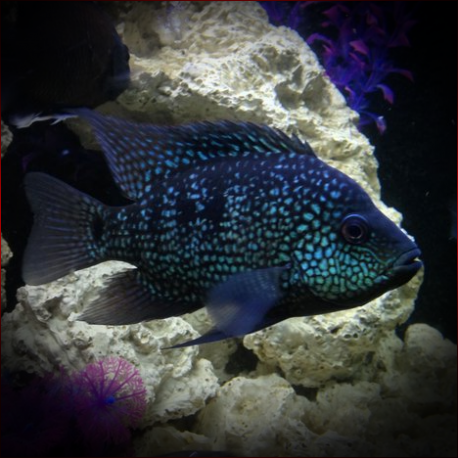More info
Datasheet
| Minimum Tank Size | 200 litres / 52.83 US gallons |
| Maximum Size | 30.5cm / 12.01inches |
| Temperament | Aggressive |
| Care Description | Difficult |
| Temperature | 20.0°C / 68.00°F - 23.9°C / 75.02°F |
| Carbonate Hardness | 5-12 |
| pH | 6.5-7.5 |
General Description
The Texas Cichlid, scientifically known as Herichthys cynoguttatus, is a species of freshwater fish belonging to the Cichlidae family. It is characterized by its iridescent golden color with pearl highlights, white dots on its body and fins, along with small black spots at certain areas. Juveniles of this species exhibit a pearl-gray body with white dots and black spots. The males typically grow larger and develop a cranial bump as they mature.
Aquarium Setup
To house a Texas Cichlid, a minimum tank size of 200 litres (around 50 gallons) is recommended. The aquarium should have a fine sand substrate and ample rocks, roots, and hardy plants for hiding spots and territorial boundaries. Floating plants can serve as cover for these fish. Regular water changes of 1/4 to 1/2 of the tank volume weekly are necessary due to the species' sensitivity to stagnant water. Maintaining neutral water conditions with a pH of 6.5-7.5, a hardness of 5-12 KH, and temperatures ranging from 20.0-23.9°C (68-75°F) is ideal. Care must be taken when selecting tank mates, opting for more aggressive fish species.
Behaviour
Texas Cichlids are known for their territorial and somewhat aggressive nature. They require well-defined territories within the aquarium. These fish can be picky about their surroundings, so regular maintenance and monitoring of water quality are essential. Texas Cichlids are open breeders, showing parental care to their fry but may exhibit cannibalistic behavior towards their offspring.
Feeding and Diet
Being omnivorous, Texas Cichlids have a varied diet consisting of prepared and frozen foods like bloodworms, tubifex, ocean plankton, as well as flake food and Cichlid pellets. Their diet should encompass a mix of protein-rich and plant-based foods to ensure proper nutrition and overall health.
Reproduction & Dimorphism
Texas Cichlids are relatively challenging to sex, with females being less brightly colored and generally smaller than males. During breeding, these fish lay up to 500 eggs on cleaned rocks. Both parents guard the fry, which are suspended from stones. Male Texas Cichlids may develop a noticeable cranial bump as they age.
Habitat and Distribution
Native to the Rio Grande in Texas, hence the name, these cichlids prefer warm, slow-moving waters with rocky substrates. They can also be found in parts of northeastern Mexico, inhabiting a variety of freshwater habitats within their range.

